Last Updated on July 11, 2023
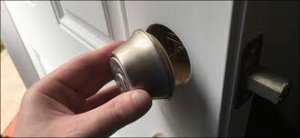 What You Need to Know Before Buying New Locks
What You Need to Know Before Buying New Locks
When you’ve made the decision to buy new locks for your home, there are some critical terms and measurements to know. This article explains what you need to know to replace door hardware successfully, the FIRST time.
A locksmith shop or door hardware showroom will need these answers to choose the right versions of the door lock products you select in order to make a smooth transition to more beautiful doors. If ordering online, you will be expected to know this information.
We will be focusing on what are known as ‘tubular’ lock sets, which are the most common found in homes in America.
Before buying new locks, you need to: know how many of each lock type you need, determine your lock’s keyway, determine the door handing for the door, find the lock backset, and determine the existing lock’s footprint.
Jump to:
- Determine Your Lock Needs
- Determine Your Door Handing and Door Swing
- Find Your Lock Backset
- What are Lock Functions?
- Consider Your Existing Lock Footprint
- Misc Considerations
- Our Article How to Replace a Lock (swapping locks)
- Our Article How to Install a Lock (drilling of the hole)
Determine Your Lock Needs
The best place to start is to make a list of all the doors of your home, and give them a name that you can remember them by. “Front door security gate” or “Kitchen Pantry Door” are examples.

You want to name them in a way that is clear to you and won’t be confused with another door by mistake. So, if you have a door from the kitchen into the garage, and in the garage you have a door leading outside the house, and another from the garage to a storage room, you can call them “kitchen to garage door”, “garage to outside door” and “garage to storage room door”, so you can be sure to not get confused about which particular door you are referring to. Unless you will be seeking a locksmith for home’s help in replacing door locks, this list is just for your reference to be certain that you have all doors covered and establish the count of the locks you will need.
However, be sure to share it if you’ve hired someone for the installation. It will help them install the right locks on the correct doors.
How to Determine Your Lock’s Keyway
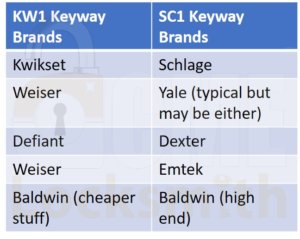
If you are replacing every keyed lock with a new keyed lock, this may not be important. But if you are only replacing locks on one or a few doors, this is essential information.
When you want to match your existing key, you will need to buy locks that use the same keyway as your existing lock so the new locked can be rekeyed to match the existing key.
One way to do this is to simply by the same brand that is currently installed. But there are other brands that use common keyways. There are two major keyways available. Schlage and Kwikset. This table shows some common brands that use each keyway.
What is Door Handing?

If you plan on buying lever-style locks, door handing is VERY important.
Simply put, door handing refers to 1) the direction the door swings when it opens and 2) from which side, left or right, that the door is hinged.
In simplest terms, you can determine your door’s handing by determining which hand you would use to open the door. If you naturally want to use your left hand, the door is left handed. If you naturally want to use your right hand, the door is right handed.
Door handing helps with three things. It determines which side of the door lock will take the key, it makes sure the levers point toward the hinged side correctly, and it makes sure the door latch will latch correctly when the door is closed.
Th door handing determination is always made from what would be considered ‘outside’ the door. The outside is the side where keys would be used if the door had a locking function.
So, on the front door, it’s from the outside of your home looking in. In a bedroom, bathroom, or pantry, it’s from the outside space from these rooms, looking in.
For doors that swing into a room space, hinges on the left mean it’s a left-handed (LH) door, and hinges on the right mean it’s a right-handed (RH) door. You can also think of this as which hand you would normally use to open the door. If you would use your left hand, it’s a left-handed door.
For doors that swing toward you, hinges on the left mean the door handing is left-hand-reverse (LHR) door, and hinges on the right mean it’s a right-hand-reverse (RHR) door.
The ‘Reverse’ aspect refers to the latch portion of the hardware, ensuring the latch hits the strike plate correctly to allow the door to close.
If your chosen door locks require door handing information, it’s important that you request it correctly, as specialty hardware often has long lead times for shipping.
A lot of new mass-produced door locks from manufacturers are now being released with ‘field reversible’ door handing. That means that they’ve built their door locks in such a way that it can be adjusted to work on all doors, regardless of whether the door swings in or out, or to the left or the right.
This is a very common on door locks purchased from a big-box store. But some design styles (most commonly levers) will require handing, and most of the upscale, custom, very decorative door lock manufacturers will require door handing information.
How to Determine the Lock Backset
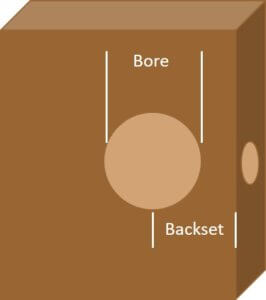
The next piece of important information is determining the ‘backset’ of your locks. This is the distance from the edge of the door (where the latch projects from), to the CENTER of the bore hole where the lock is installed.
Think of a lock backset as: “how far is the center of the lock set back from the edge of the door”
In the U.S., there are two common lock backsets, 2-3/8 inch and 2-3/4 inch. Although not common, it’s entirely possible that some doors on your home may have a different backset than the others, so you need to check each door. Many of the most common locks are coming with adjustable latches to switch between the two so look for those if this is the case.
It can sometimes be a little tricky with such a small difference to determine the lock backset. Usually, if you place a level on the top of the existing lock (if the rosette, the portion of the lock that touches the door, is round), and level it, it will be resting very close to the center-line, and you can get an accurate measurement. In rare cases, you may need to remove the existing door locks to determine it correctly.
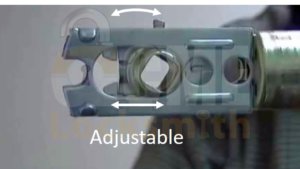
Other than replacement parts, most manufacturers aren’t making new products with lock backsets other than the 2-3/8 and 2-3/4 sizes. It’s possible if you have a lock backset other than those you may have to replace the door if a matching door latch cannot be found in your selected hardware styles, or you may need to bore new holes for the lock sets, and use some sort of filler plate to plug the other holes.
But always check with your local locksmith for odd-sized lock backset latches before taking action. They will likely have the latch that you need. As an example, here in Arizona\ we often see 5-inch backsets that require a 5-inch latch not found at the big box stores. We specifically stock these for our customers.
Knowing the Lock Functions
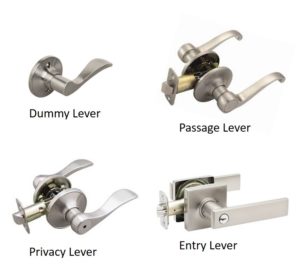
The next piece of information you’ll need is a decision from you, which function lock do you want to use on the door. For detailed article on locks functions see our article Understanding Lock Functions. As a summary, For most homes, a lock set can be one of three functions:
- Passage: the lock has no ability to be locked from either side. Used commonly for things like closets or pantries.
- Privacy: the lock has no key, but can be locked from the inside with either a thumb-turn, a button, or by pressing in on the knob slightly and rotating the knob. Privacy locks can be opened from the outside using a small tool provided by the manufacturer or purchased from a locksmith.
- Entry: the lock has a keyed cylinder on the outside, and on the inside a means to unlock the door such as a button or thumb-turn.
- Dummy: the lock isn’t even a lock. It’s just screwed onto the door to look like the other locks you have, but can be used for doors that either don’t function (decorative), or for doors like linen closets that stay closed by the use of small magnets or ball catch latches. Dummy levers are always handed so door swing needs to be considered.
Which lock function you use is a personal choice of the home owner. You may want a pantry door that you can lock. You may not want a lock on the front door lever, preferring using just a deadbolt above for quicker access.
Consider Existing Lock Footprint
Footprints refer to the portion of the lock set that touches the door that it’s attached to.
It’s only an aesthetic consideration. If you chose new door locks that do not match or exceed the existing hardware’s footprint, you may wind up with a door that reveals where the hardware has been replaced.
When you take the old lock off, there can be three things that reveal the old locks footprint:
- An impression – a ring where the old locks rosette touched the door
- Chipping -where pain has peeled off when the lock was removed.
- Lack of paint or stain – when there was no paint or stain under the old lock
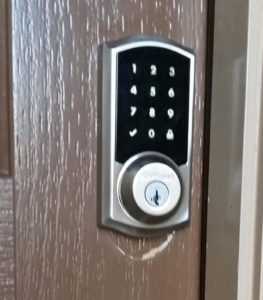
It’s not usually difficult to match or exceed a footprint for knobs, levers, and deadbolts. The one exception being replacing deadbolts with new keyless (electronic) deadbolts (check out our 3 Favorite Keyless Home Deadbolts).
For some reason lock manufactures have made ALL the keyless deadbolts with a smaller width footprint. Be prepared to touch up or refinish the door when adding a keyless deadbolt when you want a clean finished look.
Handle sets (the long vertical handles that often have a thumb press lever to open them), are nearly impossible to match. Hardware makers change their styles over time, so this becomes an issue.
If you plan on replacing the old handle set with a new handle set, you need to either ensure that the replacement will fit into the previously bored holes from the old hardware, or be prepared to drill new ones and find a means of filling the spaces of the old ones.
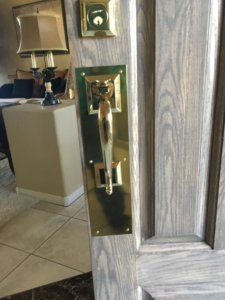
Important measurements for this are the distance (center to center) between the deadbolt hole and knob/lever hole, and often there is a screw hole in the bottom of the handle set that will likely not be in the same place in a replacement (this last one can usually be filled with wood putty or an equivalent).
In extreme cases, you’ll either end up having to replace the door or installing a cover plate that can be used to secure the modern locks and block out all previous holes / cuts..
Other Considerations
When replacing older hardware, you’ll find that newer door locks may not fit the existing bore holes. This is in part from standards changing over the years, and in part because you are more likely to have at least portions of the lock parts that are adjustable today, and the existing holes won’t accommodate, say, the length of an adjustable latch.
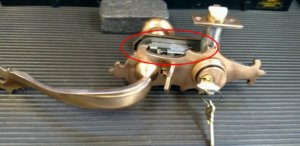
There are door hole prep kits (see our article with links to our favorite products at How to Install Door Locks) that can help you make these hole size adjustments cleanly, and they are worth the additional cost to do the job correctly. Or, you can hire your local locksmith to perform the installation.
One lock we often see is that of old Schlage E-series handle sets. These are no longer made and the door prep was entirely different than for modern locks.
While you are in that hardware showroom, you might find the manufacturer offers matching hardware for kitchen cabinets, towel racks, and other hardware for your home to really bring the design elements together in the entire home.
When ordering door locks from a local locksmith or online, you can specify “Keyed Alike” (KA), so all your locks will work using the same key before you install the locks. If you’ve forgotten and desire them to work from one key, you can always take them to your local locksmith to key them for you.
Alternatively, you can order the new door locks “Keyed Differently” if you have one or two doors that you’d like to operate off of different keys. Think about this when you are reviewing your door hardware selection, as it removes an additional need to change them later.
Putting It All Together
Once you’ve gotten your measurements from all your doors listed out, the door handing, and the functions for the locks you will need, you can walk into any locksmith shop or showroom knowing you’ll be prepared for the questions you may be asked.
All that’s left is to select a lock style and finish color that appeals to you, and waiting for your order to be put together. Enjoy your new locks!
Disclosure: As an Amazon Associate I earn from qualifying purchases.
